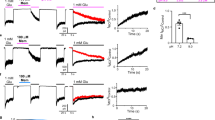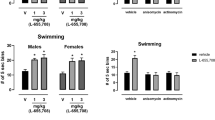Abstract
Electrophysiological studies indicate the existence of several types of receptors for excitatory amino acids1. Thus, responses induced by N-methyl-D-aspartate (NMDA) are potently and selectively blocked by D(—)-2-amino-5-phosphonopentanoic acid (D-AP5), while responses induced by such agonists as kainate and quisqualate are relatively resistant to this antagonist2,3. Evidence is mounting that excitatory amino acid receptors are involved in synaptic excitation in many regions of the central nervous system (see refs 1 and 4 for reviews). Although the identity of the transmitter(s) acting at these receptors remains uncertain5, L-aspartate has been considered the most likely transmitter at NMDA receptors and L-glutamate at kainate/quisqualate receptors1,4. Other endogenous acidic amino acids proposed as possible transmitters include a range of sulphur-containing amino acids6 and the tryptophan metabolite, quinolinic acid7. Ligand-binding studies offer a means not only of assessing receptor densities in different brain regions but also of comparing affinities of transmitter candidates for these receptors. However, to avoid difficulties of interpretation arising from the use of ligands which bind to more than one type of receptor, such as [3H]-L-glutamate and [3H]-L-aspartate (for example, refs 8–12), ligands with high receptor selectivity are required. Here, we report that [3H]-D-AP5 binds specifically to rat brain membranes, that the hippocampus and cerebral cortex are enriched in these sites relative to other brain areas and that L-glutamate has higher affinity for these receptors than have all other transmitter candidates tested.
This is a preview of subscription content, access via your institution
Access options
Subscribe to this journal
Receive 51 print issues and online access
$199.00 per year
only $3.90 per issue
Buy this article
- Purchase on Springer Link
- Instant access to full article PDF
Prices may be subject to local taxes which are calculated during checkout
Similar content being viewed by others
References
Watkins, J. C. & Evans, R. H. A. Rev. Pharmac. Toxicol. 21, 165–204 (1981).
Evans, R. H., Francis, A. A., Jones, A. W., Smith, D. A. S. & Watkins, J. C. Br. J. Pharmac. 75, 65–75 (1982).
Davies, J. & Watkins, J. C. Brain Res. 235, 378–386 (1982).
Fagg, G. E. & Foster, A. C. Neuroscience 9, 701–719 (1983).
Watkins, J. C. in Amino Acid Neurotransmitters (eds Mandel, P. & DeFeudis, F. V.) 205–212 (Raven, New York, 1981).
Mewett, K. N., Oakes, D. J., Olverman, H. J., Smith, D. A. S. & Watkins, J. C. in CNS Receptors—From Molecular Pharmacology to Behaviour (eds Mandel, P. & DeFeudis, F. V.) 163–174 (Raven, New York, 1983).
Stone, T. W. & Perkins, M. N. Eur. J. Pharmac. 72, 411–412 (1981).
Baudry, M. & Lynch, G. J. Neurochem. 36, 811–820 (1981).
Sharif, N. A. & Roberts, P. J. Brain Res. 211, 293–303 (1981).
Di Lauro, A., Meek, J. L. & Costa, E. J. Neurochem. 38, 1261–1267 (1982).
Werling, L. L. & Nadler, J. V. J. Neurochem. 38, 1050–1062 (1982).
Fagg, G. E., Foster, A. C., Mena, E. E. & Cotman, C. W. Eur. J. Pharmac. 88, 105–110 (1983).
Davies, J., Evans, R. H., Jones, A. W., Smith, D. A. S. & Watkins, J. C. Comp. Biochem. Physiol. 72 C, 211–224 (1982).
Davies, J. & Watkins, J. C. J. Physiol. Lond. 332, 108–109P (1982).
Ferkany, J. W. & Coyle, J. T. Life Sci. 33, 1295–1305 (1983).
Cheng, V. C. & Prusoff, W. H. Biochem. Pharmac. 22, 3099–3108 (1973).
Lowry, O. H., Rosebrough, N. J., Farr, A. L. & Randell, R. J. J. biol. Chem. 193, 265–275 (1951).
Barlow, R. B. in Biodata Handling with Microcomputers 135 (Elsevier, Cambridge, 1983).
Perkins, M. N., Collins, J. F. & Stone, T. W. Neurosci. Lett. 32, 65–68 (1982).
Glowinski, J. & Iversen, L. L. J. Neurochem. 13, 655–669 (1966).
Author information
Authors and Affiliations
Rights and permissions
About this article
Cite this article
Olverman, H., Jones, A. & Watkins, J. L-Glutamate has higher affinity than other amino acids for [3H]-D-AP5 binding sites in rat brain membranes. Nature 307, 460–462 (1984). https://doi.org/10.1038/307460a0
Received:
Accepted:
Issue Date:
DOI: https://doi.org/10.1038/307460a0
This article is cited by
-
The NMDA receptor regulates competition of epithelial cells in the Drosophila wing
Nature Communications (2020)
-
Ouabain Modulates the Functional Interaction Between Na,K-ATPase and NMDA Receptor
Molecular Neurobiology (2020)
-
The 1980s: d-AP5, LTP and a Decade of NMDA Receptor Discoveries
Neurochemical Research (2019)
-
The Mu-Opioid Receptor and the NMDA Receptor Associate in PAG Neurons: Implications in Pain Control
Neuropsychopharmacology (2012)
-
Potentiation of excitatory serotonergic responses by MK-801 in the medial prefrontal cortex
Naunyn-Schmiedeberg's Archives of Pharmacology (2009)
Comments
By submitting a comment you agree to abide by our Terms and Community Guidelines. If you find something abusive or that does not comply with our terms or guidelines please flag it as inappropriate.



